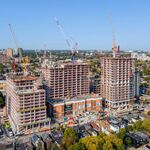http://www.torontolife.com/features/resistance-futile/?pageno=1
RESISTANCE IS FUTILE
Like it or not, big-box chains are migrating downtown. Instead of mounting protests, urbanites should embrace the monster-retail movement By Philip Preville
A 10-minute drive from the financial district and two minutes south of trendy Queen Street East, there’s an urban pocket crying out for redevelopment. Ever since the eastern leg of the Gardiner Expressway—which ran from the DVP to Leslie—was torn down in 2001 at a cost of $34 million, we’ve neglected the industrial landscape that was left behind. As a result, the streets of Leslieville all end at Eastern Avenue, where a couple of kilometre-long “super-blocks†keep the neighbourhood cordoned off from the waterfront. Some 70,000 cars a day use Eastern and Lake Shore as express routes; they remain forbidding to anyone on two feet or two wheels. Surely this is not what we tore down the Gardiner for.
In the heart of the super-blocks, where a tannery and an ironworks factory once stood, lies Toronto Film Studios, a 12-acre complex that for almost two decades has served as the primary production facility for the city’s film and television industry. It’s one of the reasons the neighbourhood was branded the Studio District. The complex is scheduled to close at the end of the year, when business will shift a kilometre southwest to the much-bally hooed mega-studio called Filmport. In its place, the landowner has proposed building a SmartCentre, the first big-box retail outlet to infiltrate downtown. Opposition to the proposal has been fierce, and in this battle, the city has become the tragic protagonist in a parable whose moral is “be careful what you wish for.â€
According to the city’s official plan, the area is one of only two remaining “employment districts†within the boundaries of the old city of Toronto, meaning that the area is reserved for industry. The other is Liberty Village, where large swaths of land have already been converted to homes and condos. The city, anxious about the declining number of jobs in the core and fearing downtown could become a bedroom community if companies continue to set up shop in the suburbs, insisted upon zero-residential, 100 per cent employment zoning in south Riverdale—which is exactly what SmartCentres is offering.
Tentatively called the Foundry District, Smart Centres’ proposal—a retail complex with 700,000 square feet of commercial space and 1,800 parking spaces—has become the latest hot-button development to go before the Ontario Municipal Board. Fighting the developers are the city, local councillor Paula Fletcher, and a highly motivated residents group, the East Toronto Community Coalition. Barring the advent of a mutual settlement—unlikely, but always a possibility—the OMB hearings will wrap up this month and a decision should be handed down before the year’s end. The fight is yet another grenade lob in that hoary trench war: the city of neighbourhoods versus the city for cars. But it’s also a Freudian psychological conflict on a massive scale, one that exposes a city-wide hypocrisy. Our civic superego tells us to tear down expressways, take transit, walk and cycle more, and otherwise reform and redirect our behaviour in pursuit of the ideal livable, green, healthy city. Meanwhile, deep in our repressed id, we are still running errands in our cars. Though we don’t like to admit it, the majority of us are big-box shoppers.
Mitchell Goldhar is a thin, bespectacled 47-year-old, born, raised, and still residing in North York. He’s the sole proprietor of SmartCentres, Canada’s most ambitious and successful retail developer, with nearly 200 single-storey, low-density big-box shopping centres built or in development across the country. No company in Ontario is better at shepherding a development application through the approvals process: SmartCentres’ projects are often hotly contested, since they usually feature Wal-Mart as their anchor tenant.
Goldhar, who teaches a course in real estate development at the Rotman School of Management, built his first shopping centre in Barrie 15 years ago and hasn’t stopped since. He owns an RV, which he takes on long road trips to scout new locations. It has been a successful research strategy: in 2007, Canadian Business ranked Goldhar at number 48 on its list of the 100 wealthiest Canadians, with a net worth of approximately $1.13 billion.
Though there are 12 SmartCentres in Toronto, none are located within the boundaries of the old city (the nearest is on Laird just south of Eglinton), and Goldhar happened upon the Studio District lands more by luck than by design. The site’s owner, Sam Reisman, runs Rose Corporation, whose diverse real estate holdings include the Elora Mill Inn and Muskoka’s Hidden Valley Resort. He’s also an investor in the new Filmport studios. In 2004, working with well-regarded urban planning consultant Ken Greenberg, Reisman put forward a proposal to break up the super-block between Carlaw and Leslie by extending the streets of Leslieville through to Lake Shore and retaining some of the tannery buildings. It featured a mix of residential and commercial spaces, including condo towers up to 14 storeys high, a hotel and 400,000 square feet of retail. Though it was well-received at first, says Reisman, “late in the game, the city had a change of heart.†Frustrated, he decided he needed a partner more adept at dealing with city hall. He called Goldhar.
SmartCentres paid $14 million for a 50 per cent stake in the 18.5-acre site. The Foundry District has since been derided as a suburban construct, anathema to a city that prioritizes pedestrians, cyclists and transit users over motorists. Along Queen East, signs in storefront windows proclaim “No Big Box in Leslieville.†They might as well proclaim No Big Box Anywhere Near Downtown. Goldhar is familiar with the critique, and his reply is gentle but firm: “Shopprs create retail concepts. If people are ready to change the way they shop, retailers and developers will oblige.â€




